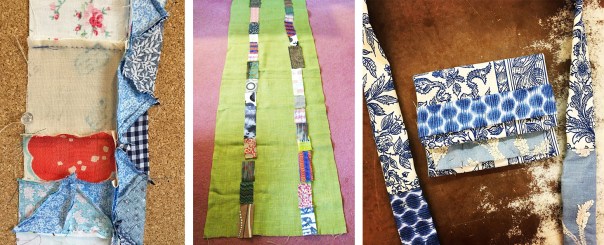
Sometimes I find and save advertising materials printed on nice paper. I might like part of the imagery, or be attracted to the weight and feel of the paper, or both. It’s sometimes less intimidating to start an art journal page on paper that already has something on it than a blank piece of paper. In this article I’ll show you two ways to creatively alter found papers with text on them.
Tools and Materials
Assorted found papers and scrap papers
Clean scrap paper
Stencils
Markers and other drawing and coloring implements of choice
Painter’s tape or masking tape
Scissors
Glue stick
Burnishing tool

First, select a piece of paper with text on it, and a stencil. Tape the stencil in place over the text. Using the marking implement of your choice, outline the openings in the stencil only in the spots where there is text to cover.
This results in an interesting effect. The text turns into a texture rather than something you read, and the resulting graphic effect might suggest what to do next to finish the composition. You might decide to color in some or all of the outlines you just traced over the text.

In the example above, since I’ve used permanent black Sharpie markers, I can use almost any medium I want to add color if I want to.

There is no need to restrict yourself to using a black marker. My brother got off to a very good start on this page. He took advantage of the pale text to use colored Sharpie markers. If he wants to work on this page more it has a lot of potential. Note: my brother died about three weeks after making this page. I don’t know if I’m going to add to it or keep it as is, but it’s in my art journal.
I have a real weakness for amoeba shapes and any graphics that suggest mid-century modern imagery. I cut these blocks of text from a magazine because of the pretty shapes and colors backing some of the text.

The article I took these cutouts from was about work-life balance. There are some words in these paragraphs that would be good to have in my art journal, which I use as a self-care tool as well as for creative expression. I covered up the words I didn’t want to see with strips of scrap paper and left exposed the words I did want to see. When the glue was dry enough to handle, I trimmed the shapes. Toward the end, I got tired of gluing paper strips and for the last few lines I wanted to cover, I used a yellow opaque paint marker to finish off these pieces.

Some people compose prose or poetry this way, by removing words instead of writing them to make new compositions. In this sample I was mainly interested in making a visual statement, and I treated the words as random elements. But if you wanted to, you could make a carefully considered visual AND literary statement by selectively covering words.
Here is a two-page spread using both techniques from this article together. I think these two pages are almost complete. I’ll think about them for awhile before doing anything else to them, if I decide they need more.

It helps that these two found pages here were already strong graphically, which was part of the reason why I was attracted to them in the first place.
More Examples
Following are more art journal pages that I started by selectively covering text. Enjoy!

https://www.etsy.com/listing/1142360780/mini-cherry-blossoms-6×6-stencil






































